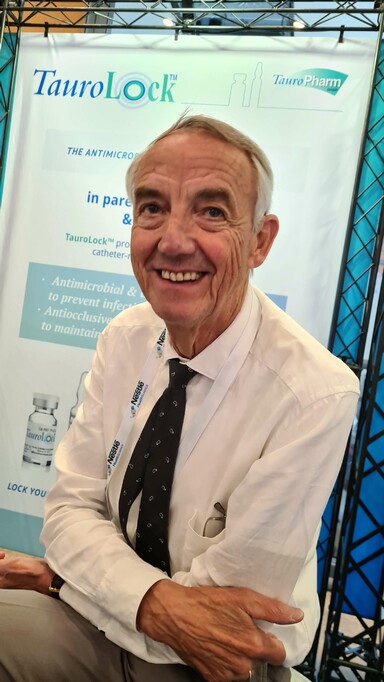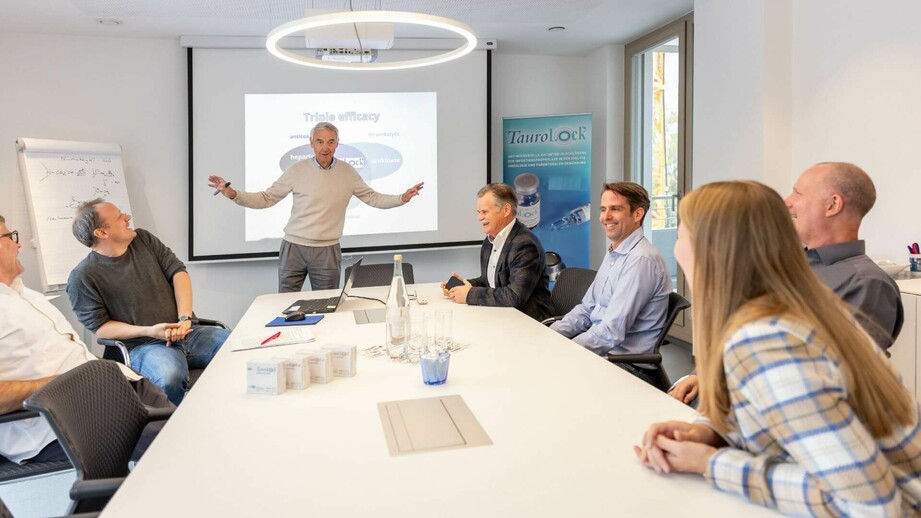20 years TauroLock™
Interview with founder Claus Herdeis
TauroLock™ officially entered the market in 2004. But where did the idea for a taurolidine-based lock solution come from in the first place? And how did this idea grow into an international business? We asked someone who knows it all: Prof. Dr. Claus Herdeis, chemist and pharmacist with 50+ years of experience and co-founder of TauroPharm. He sat down with us to tell the story of TauroLock™ behind the scenes.

Let's start at the beginning: Can you tell us a bit about your career before TauroLock™?
Sure! After finishing my A-levels, I worked in a pharmacy for two years. This allowed me to gain a lot of practical experience. I went on to study pharmacy at the University of Munich. My doctorate was in pharmaceutical chemistry and I also completed my chemistry degree at the same time. After my habilitation in chemistry and pharmacy, I became a professor at the University of Würzburg. I have worked there as a teacher and researcher since 1983 – until a new chapter began with TauroPharm.
How did the idea for TauroLock™ come about?
It all started in my working group at the university. In this group, scientific staff met once a week to discuss all kinds of topics related to amino acids. An open forum, if you will. One day, the question arose: What can you actually do with the beta-aminosulfonic acid called “taurine”? This peeked my interest, so I did a little research into literature available at the time.
We know taurine mainly from energy drinks. It’s a common ingredient of these products, although it doesn't really have a significant effect in that context. During my research, I discovered that taurolidine can be derived from taurine. Back then, there was one company in Switzerland that did this. Why? Because taurolidine has a special antimicrobial effect. But the Swiss company's synthesising process was extremely complex. Producing taurolidine based on taurine results in a huge amount of waste. That's why we asked ourselves: Couldn't it be simpler?
I brought this question to my working group at university. A week later, two participants approached me and said they had an idea. One of them was Christian Weis – chemist and later co-founder of TauroPharm GmbH. So in 1998, we started tinkering in the laboratory in the evenings and at night. The result was a patented process for the chemical production of taurolidine.
How did the synthesis of taurolidine lead to TauroLock™?
In 2000, we founded the company TauroPharm after receiving the patent for our synthesis method. We then joined forces with an American company called Biolink. This collaboration resulted in the product Neutrolin: an antimicrobial lock solution based on 1.35 % taurolidine and 4 % citrate. We produced Neutrolin and Biolink brought it onto the market. Unfortunately, Biolink went bankrupt in 2002. We acted quickly and renamed Neutrolin as TauroLock™. Thus, the much-needed product was back on the market – and TauroPharm became the sole manufacturer and distributor of this product.

... and the rest is history! Were there any other important milestones after the market launch in 2004?
Oh yes, the development of TauroLock™-HEP500 was very important: This product finally solved the problem of insufficient flow rates in dialysis. With the addition of 500 IU/ml of heparin, patients have even greater protection against biofilm and occlusion. In 2011, TauroLock™-U25.000 was added: The product variant with the fibrinolytic active ingredient urokinase. Since then, the TauroLock™ 2+1 protocol has been our gold standard for dialysis: TauroLock™-HEP500 twice a week and TauroLock™-U25.000 once a week to effectively prevent catheter-related occlusions and complications.
Do you see any potential for TauroLock™ that has not been fully realised yet?
I think for TauroLock™ solutions, we’ve got all the relevant fields of application well covered by now: dialysis, parenteral nutrition, oncology and intensive care. But taurolidine for infection prevention in general – there's still so much to be explored! We have already entered one other large field with TauroPace™: This solution is also based on taurolidine and was developed to prevent infections related to cardiac implantable electronic devices (CIED). My vision for the next 10 years: Taurolidine should be used in more and more medical fields. I see particularly great potential in orthopaedics, trauma surgery, and urology.
Thank you very much for your insights! Finally, a question for the future of research: What advice would you give to scientists who are currently trying to develop an innovative product?
Well, I do indeed have some pieces of advice to share. Number one: If you have a brilliant idea, stay on it! Don't get discouraged and keep on researching, even if it takes a lot of patience. Secondly, have a look at established active ingredients for positive and negative side effects. This can lead to new forms of application. And thirdly, always seek active exchanges with other scientists. You won't get far if you just lock yourself up in the lab or library. Turning ideas into tangible concepts and methods will never work without new perspectives – and that includes critical objections. In my experience, open dialogue is the key to sustainable progress in science.



